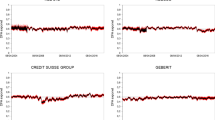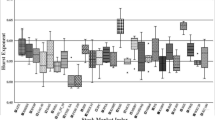Abstract
Correlations among stock returns during volatile markets differ substantially as compared to those from quieter markets. During times of financial crisis, it has been observed that the ‘traditional’ dependencies in global markets break down. However, such an upheaval in the dependency structure happens over a span of several months, with the breakdown coinciding with a major bankruptcy or a sovereign default. An important aspect of risk management is to effectively identify the duration of breakdown and create tailor-made models for these extreme events; nevertheless, there are few statistical methods to identify such significant breakdowns. The purpose of this paper is to propose a simple test to detect such structural changes in global markets. This test relies on the assumption that asset price follows a Geometric Brownian Motion. We test for a breakdown in dependence structure using eigenvalue decomposition of the correlation matrix. We derive the asymptotic distribution of the test statistic under the null hypothesis and apply the test to stock returns. We also compute the power of this proposed test and compare it with the power of other existing tests. Through extensive experimentation, we show that the proposed test is able to effectively detect the times of structural breakdown in global stock markets, despite the simplifying assumption of Geometric Brownian Motion of stock prices.




Similar content being viewed by others
References
Anderson Theodore Wilbur. Asymptotic theory for principal component analysis. Ann Math Stat. 1963;34(1):122–48.
Aue Alexander, Hörmann Siegfried, Horváth Lajos, Reimherr Matthew, et al. Break detection in the covariance structure of multivariate time series models. Ann Stat. 2009;37(6B):4046–87.
Black Fischer, Scholes Myron. The pricing of options and corporate liabilities. J Political Econ. 1973;81(3):637–54.
Bolton Richard J., Hand David J. Statistical fraud detection: A review. Statistical science, pages 235–249, 2002.
Damiano Brigo, Antonio Dalessandro, Matthias Neugebauer, and Fares Triki. A stochastic processes toolkit for risk management. Available at SSRN 1109160, 2007.
Cabrieto Jedelyn, Tuerlinckx Francis, Kuppens Peter, Hunyadi Borbála, Ceulemans Eva. Testing for the presence of correlation changes in a multivariate time series: a permutation based approach. Sci Rep. 2018;8(1):769.
Chin Richard, Lee Bruce Y. Principles and practice of clinical trial medicine. Elsevier, 2008.
Da Costa Dias Alexandra, Embrechts P. Change-point analysis for dependence structures in finance and insurance. 2004.
Forbes Kristin J, Rigobon Roberto. No contagion, only interdependence: measuring stock market comovements. The journal of Finance, 2002; 57 (5): 2223–2261
Goetzmann William N, Li Lingfeng, Rouwenhorst K Geert. Long-term global market correlations. Technical report, National Bureau of Economic Research, 2001.
Harchaoui Zaid, Cappé Olivier. Retrospective mutiple change-point estimation with kernels. In 2007 IEEE/SP 14th Workshop on Statistical Signal Processing, pages 768–772. IEEE, 2007.
Hull John C. Options futures and other derivatives. Pearson Education India, 2003.
Jennrich Robert I. An asymptotic \(\chi \)2 test for the equality of two correlation matrices. J Am Stat Assoc. 1970;65(330):904–12.
Killick Rebecca, Fearnhead Paul, Eckley Idris A. Optimal detection of changepoints with a linear computational cost. J Am Stat Assoc. 2012;107(500):1590–8.
Krishnan CNV. Ralitsa Petkova, and Peter Ritchken. Correlation risk. J Empirical Finance. 2009;16(3):353–67.
Marathe Rahul R, Ryan Sarah M. On the validity of the geometric Brownian motion assumption. Eng Econ. 2005;50(2):159–92.
Muggeo Vito MR, Adelfio Giada. Efficient change point detection for genomic sequences of continuous measurements. Bioinformatics. 2010;27(2):161–6.
Pearson ES, Wilks SS. Methods of statistical analysis appropriate for k samples of two variables. Biometrika. 1933;25(3/4):353–78.
Reddy Krishna, Clinton Vaughan. Simulating stock prices using geometric Brownian motion: evidence from Australian companies. Aust Accounting, Business Finance J. 2016;10(3):23–47.
Ross Sheldon M. Introduction to probability models. Academic press, 2014.
Shao Xiaofeng, Zhang Xianyang. Testing for change points in time series. J Am Stat Assoc. 2010;105(491):1228–40.
Weisstein Eric W. Cubic formula, from mathworld–a wolfram web resource., 2018. URL http://mathworld.wolfram.com/CubicFormula.html. Accessed: 2018-03-11.
Wied Dominik. A nonparametric test for a constant correlation matrix. Econ Rev. 2017;36(10):1157–72.
Wied Dominik, Krämer Walter, Dehling Herold. Testing for a change in correlation at an unknown point in time using an extended functional delta method. Econ Theory. 2012;28(3):570–89.
Author information
Authors and Affiliations
Corresponding author
Ethics declarations
Conflict of interest
The authors declare that they have no conflict of interest.
Additional information
Publisher's Note
Springer Nature remains neutral with regard to jurisdictional claims in published maps and institutional affiliations.
This article is part of the topical collection “Computational Statistics” guest edited by Anish Gupta, Mike Hinchey, Vincenzo Puri, Zeev Zalevsky and Wan Abdul Rahim.
Rights and permissions
About this article
Cite this article
Kasa, S.R., Bhattacharyya, M. A Statistical Test for Detecting Dependency Breakdown in Financial Markets. SN COMPUT. SCI. 2, 322 (2021). https://doi.org/10.1007/s42979-021-00671-z
Received:
Accepted:
Published:
DOI: https://doi.org/10.1007/s42979-021-00671-z




